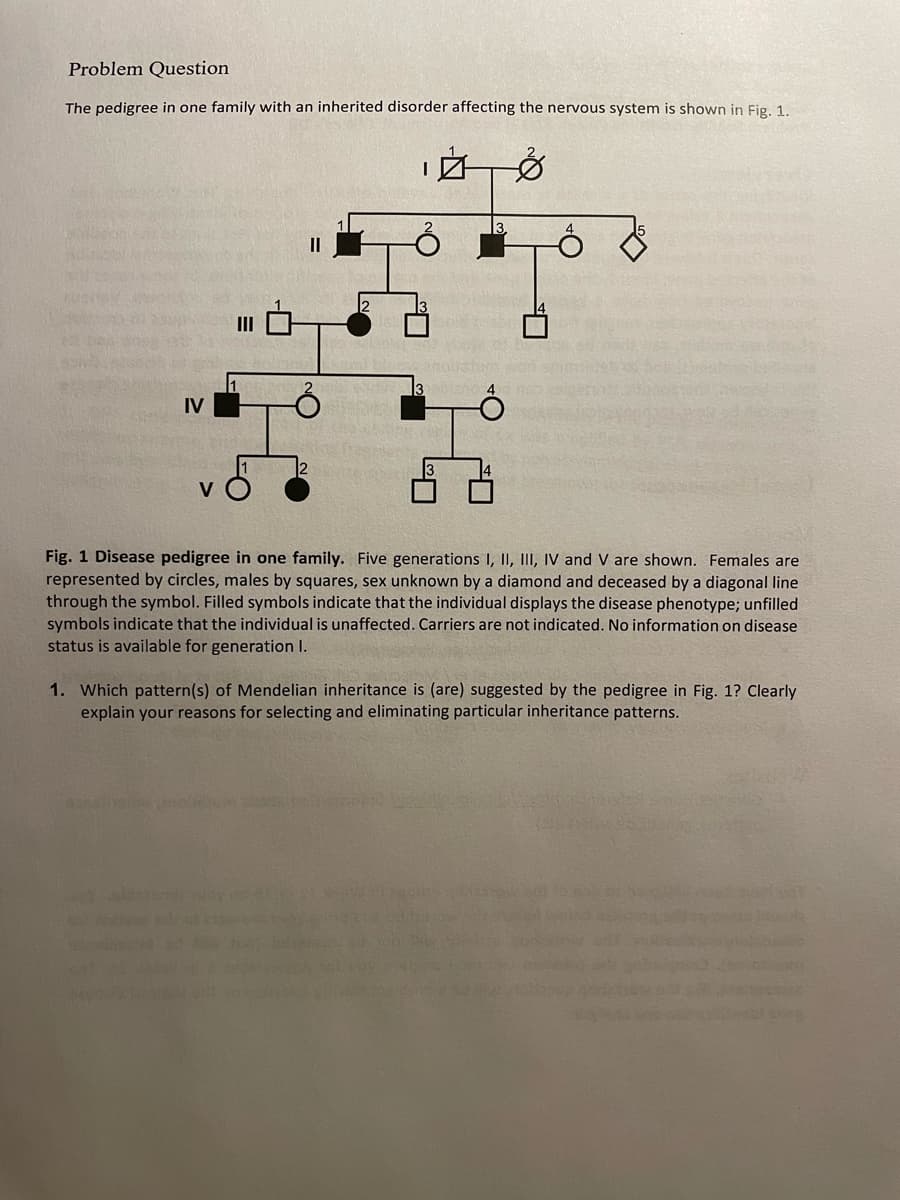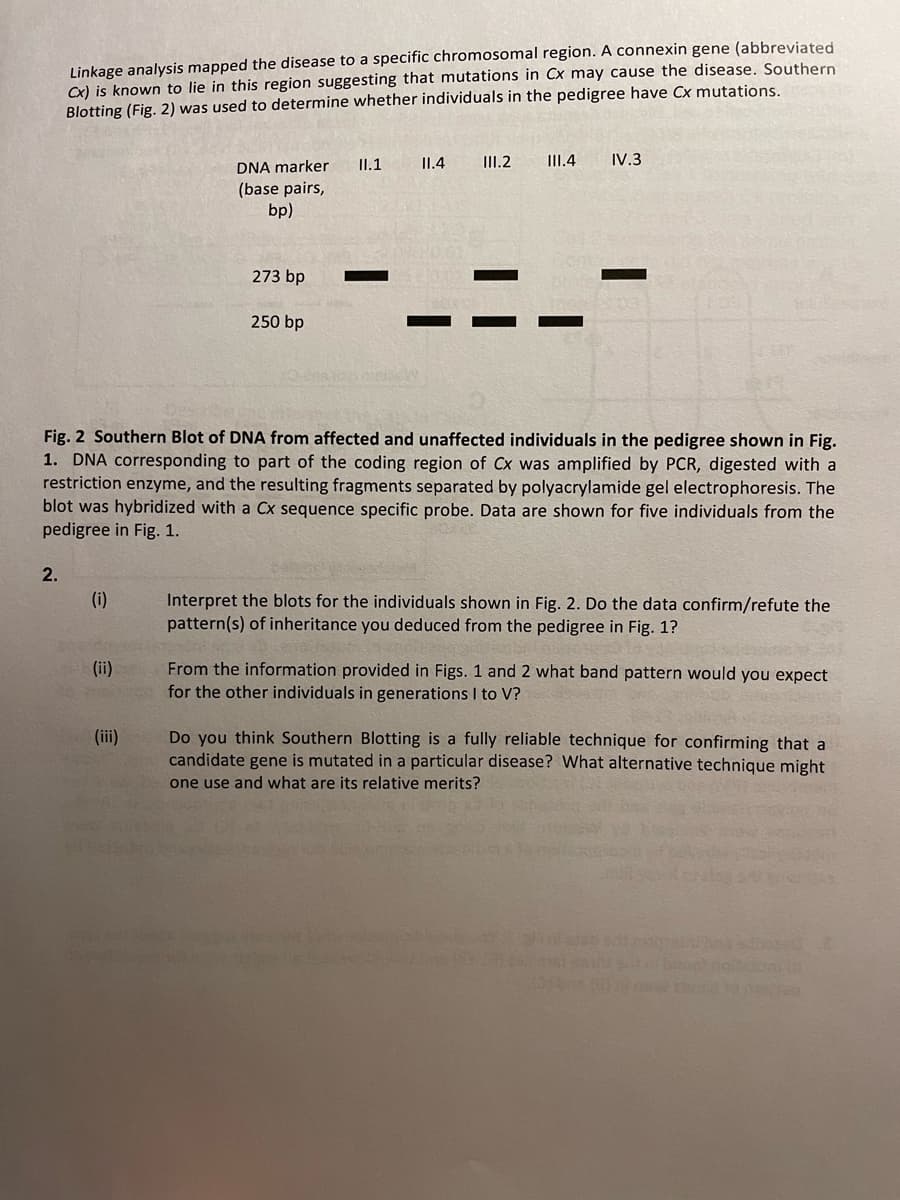IV V Fig. 1 Disease pedigree in one family. Five generations I, II, III, IV and V are shown. Females are represented by circles, males by squares, sex unknown by a diamond and deceased by a diagonal line through the symbol. Filled symbols indicate that the individual displays the disease phenotype; unfilled symbols indicate that the individual is unaffected. Carriers are not indicated. No information on disease status is available for generation I. d E 1. Which pattern(s) of Mendelian inheritance is (are) suggested by the pedigree in Fig. 1? Clearly explain your reasons for selecting and eliminating particular inheritance patterns. emphs inmoble
IV V Fig. 1 Disease pedigree in one family. Five generations I, II, III, IV and V are shown. Females are represented by circles, males by squares, sex unknown by a diamond and deceased by a diagonal line through the symbol. Filled symbols indicate that the individual displays the disease phenotype; unfilled symbols indicate that the individual is unaffected. Carriers are not indicated. No information on disease status is available for generation I. d E 1. Which pattern(s) of Mendelian inheritance is (are) suggested by the pedigree in Fig. 1? Clearly explain your reasons for selecting and eliminating particular inheritance patterns. emphs inmoble
Human Anatomy & Physiology (11th Edition)
11th Edition
ISBN:9780134580999
Author:Elaine N. Marieb, Katja N. Hoehn
Publisher:Elaine N. Marieb, Katja N. Hoehn
Chapter1: The Human Body: An Orientation
Section: Chapter Questions
Problem 1RQ: The correct sequence of levels forming the structural hierarchy is A. (a) organ, organ system,...
Related questions
Question

Transcribed Image Text:Problem Question
The pedigree in one family with an inherited disorder affecting the nervous system is shown in Fig. 1.
Ő
IV
V
|||
sopisin mob
I
Fig. 1 Disease pedigree in one family. Five generations I, II, III, IV and V are shown. Females are
represented by circles, males by squares, sex unknown by a diamond and deceased by a diagonal line
through the symbol. Filled symbols indicate that the individual displays the disease phenotype; unfilled
symbols indicate that the individual is unaffected. Carriers are not indicated. No information on disease
status is available for generation I.
1. Which pattern(s) of Mendelian inheritance is (are) suggested by the pedigree in Fig. 1? Clearly
explain your reasons for selecting and eliminating particular inheritance patterns.

Transcribed Image Text:Linkage analysis mapped the disease to a specific chromosomal region. A connexin gene (abbreviated
Cx) is known to lie in this region suggesting that mutations in Cx may cause the disease. Southern
Blotting (Fig. 2) was used to determine whether individuals in the pedigree have Cx mutations.
2.
(i)
(ii)
DNA marker
(base pairs,
bp)
(iii)
273 bp
250 bp
II.1
-
11.4
Fig. 2 Southern Blot of DNA from affected and unaffected individuals in the pedigree shown in Fig.
1. DNA corresponding to part of
coding region of Cx was amplified by PCR, digested with a
restriction enzyme, and the resulting fragments separated by polyacrylamide gel electrophoresis. The
blot was hybridized with a Cx sequence specific probe. Data are shown for five individuals from the
pedigree in Fig. 1.
SOXT
III.2 III.4
IV.3
Interpret the blots for the individuals shown in Fig. 2. Do the data confirm/refute the
pattern(s) of inheritance you deduced from the pedigree in Fig. 1?
From the information provided in Figs. 1 and 2 what band pattern would you expect
for the other individuals in generations I to V?
Do you think Southern Blotting is a fully reliable technique for confirming that a
candidate gene is mutated in a particular disease? What alternative technique might
one use and what are its relative merits?
Expert Solution
This question has been solved!
Explore an expertly crafted, step-by-step solution for a thorough understanding of key concepts.
Step by step
Solved in 3 steps

Knowledge Booster
Learn more about
Need a deep-dive on the concept behind this application? Look no further. Learn more about this topic, biology and related others by exploring similar questions and additional content below.Recommended textbooks for you

Human Anatomy & Physiology (11th Edition)
Biology
ISBN:
9780134580999
Author:
Elaine N. Marieb, Katja N. Hoehn
Publisher:
PEARSON

Biology 2e
Biology
ISBN:
9781947172517
Author:
Matthew Douglas, Jung Choi, Mary Ann Clark
Publisher:
OpenStax

Anatomy & Physiology
Biology
ISBN:
9781259398629
Author:
McKinley, Michael P., O'loughlin, Valerie Dean, Bidle, Theresa Stouter
Publisher:
Mcgraw Hill Education,

Human Anatomy & Physiology (11th Edition)
Biology
ISBN:
9780134580999
Author:
Elaine N. Marieb, Katja N. Hoehn
Publisher:
PEARSON

Biology 2e
Biology
ISBN:
9781947172517
Author:
Matthew Douglas, Jung Choi, Mary Ann Clark
Publisher:
OpenStax

Anatomy & Physiology
Biology
ISBN:
9781259398629
Author:
McKinley, Michael P., O'loughlin, Valerie Dean, Bidle, Theresa Stouter
Publisher:
Mcgraw Hill Education,

Molecular Biology of the Cell (Sixth Edition)
Biology
ISBN:
9780815344322
Author:
Bruce Alberts, Alexander D. Johnson, Julian Lewis, David Morgan, Martin Raff, Keith Roberts, Peter Walter
Publisher:
W. W. Norton & Company

Laboratory Manual For Human Anatomy & Physiology
Biology
ISBN:
9781260159363
Author:
Martin, Terry R., Prentice-craver, Cynthia
Publisher:
McGraw-Hill Publishing Co.

Inquiry Into Life (16th Edition)
Biology
ISBN:
9781260231700
Author:
Sylvia S. Mader, Michael Windelspecht
Publisher:
McGraw Hill Education